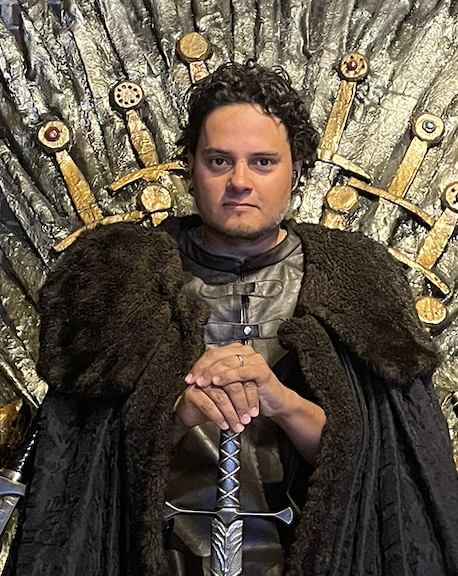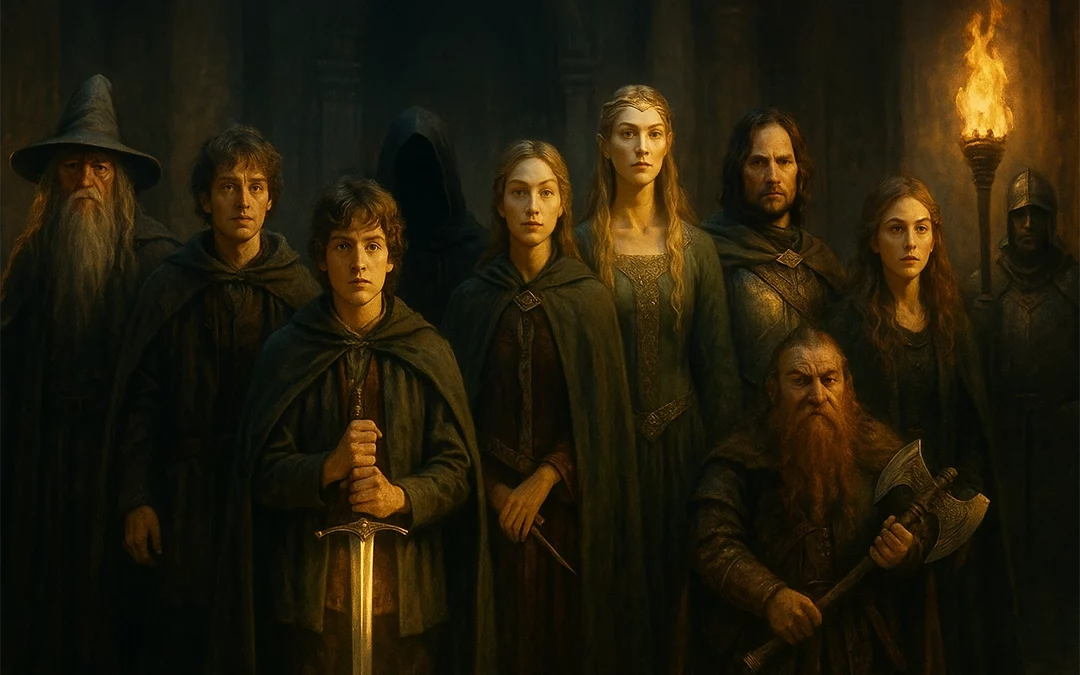If you’ve ever cracked open a fantasy novel and thought, “Here we go again—another chosen one with a prophecy and a dark lord to fight,” you’re not alone.
But here’s the twist: many of the tropes we think of as “standard fantasy fare” didn’t start where you think they did. Sure, Tolkien and Rowling are the usual suspects.
But some tropes go way further back (we’re talking Homer and Dracula-level deep cuts), while others popped up in surprising corners of early 20th-century fiction.
So, let’s take a nerdy little walk through the bookshelf of time and trace where your favourite fantasy tropes actually came from—and how other authors picked them up, twisted them, or straight-up subverted them.
The Chosen One Fantasy Trope: Not Just Harry, Frodo, or Rand
Ah, the Chosen One™. The orphaned farm boy. The girl with a birthmark shaped like a phoenix. The reluctant teenager who’s the “last hope of the realm.”
This trope is everywhere—from Star Wars to The Wheel of Time—but it predates modern fantasy by centuries.
Ancient Roots of The Chosen One
Think Achilles in Homer’s Iliad—fated for glory, doomed to die young. Or King Arthur, who pulls the sword from the stone in Malory’s Le Morte d’Arthur (1485). These guys walked so Harry Potter could run.
In Fantasy Lit
Tolkien’s Aragorn is a classic: the hidden heir to the throne of Gondor, raised in secret, revealed at the right time. Then there’s Taran in Lloyd Alexander’s Chronicles of Prydain, who begins life as a pig-keeper and ends up… well, spoiler alert.
But modern authors started to get cheeky with it:
- R. Scott Bakker (Prince of Nothing) questions if prophecy is just manipulation.
- Lev Grossman (The Magicians) gives us a chosen one who’s more depressed grad student than saviour.
Key Books:
- The Lord of the Rings (Tolkien, 1954)
- A Wizard of Earthsea (Le Guin, 1968)
- Harry Potter and the Philosopher’s Stone (Rowling, 1997)
- The Wheel of Time (Jordan, 1990)
- The Name of the Wind (Rothfuss, 2007)
The Dark Lord Fantasy Trope: Evil Incarnate… or Is He?
Cue the dramatic music. The big bad. The hooded figure. The flaming eye. We all know this guy.
But guess what? He’s older than Sauron.
Dracula Did It First
Before Mordor was even a concept, Dracula (1897) was creeping around Victorian England, commanding wolves, seducing innocents, and spreading plague-like dread. He had a lair, an army, and a goal. Textbook Dark Lord behaviour.
And Bram Stoker even referenced the Scholomance—a legendary devil-run school for sorcerers. (More on that below.)
Then Came Tolkien
Tolkien didn’t invent the Dark Lord, but he crystallised the aesthetic. Sauron is the blueprint: faceless, unkillable, omnipresent, controlling armies of orcs and wraiths.
After that, the floodgates opened:
- Lord Foul in Thomas Covenant
- The Crimson King in The Dark Tower
- Voldemort, who added a good dose of childhood trauma and no nose
- Then Joe Abercrombie came along and said, “What if your wise old mentor was the Dark Lord all along?” (Looking at you, Bayaz.)
Key Books:
- Dracula (Stoker, 1897)
- The Lord of the Rings (Tolkien, 1954)
- The Black Company (Cook, 1984)
- Harry Potter series (Rowling, 1997–2007)
- The First Law series (Abercrombie, 2006–)
The Fellowship & The Epic Quest: Let’s Get the Band Together
There’s something deeply satisfying about a mismatched group of misfits heading out on a dangerous journey.
But Tolkien didn’t invent the idea of a heroic squad either.
Mythic Vibes
Jason and the Argonauts? That’s an ancient Greek adventuring party. Arthur and the Knights of the Round Table? Classic questing bros.
And don’t forget Dorothy, Scarecrow, Tin Man, and Cowardly Lion (1900). That’s a fellowship if I’ve ever seen one.
Tolkien Made It Legendary
Tolkien gave us the Fellowship of the Ring—men, hobbits, elves, dwarves, and one meddling wizard, all united by a common cause.
Later authors took the formula and ran with it:
Dragonlance gave us a D&D-style crew (literally—it started as a D&D campaign).
Kings of the Wyld by Nicholas Eames gave us a washed-up mercenary band getting the gang back together for one last tour (like if Led Zeppelin fought monsters).
Key Books:
- The Wonderful Wizard of Oz (Baum, 1900)
- The Lord of the Rings (Tolkien, 1954)
- Dragonlance Chronicles (Weis & Hickman, 1984)
- Kings of the Wyld (Eames, 2017)
The Magical School: Before Hogwarts, There Was Roke
Let’s be real: if you could go to school anywhere, you’d probably choose one with spellbooks, floating candles, and a suspiciously dangerous Forbidden Forest.
But Rowling didn’t invent magical schools either.
Scholomance: The OG Magic School
The idea goes way back to Eastern European folklore. The Scholomance was a mythical Romanian school of black magic, allegedly run by the Devil himself. Bram Stoker even name-dropped it in Dracula.
Earthsea Did It First
In A Wizard of Earthsea (1968), Ursula K. Le Guin introduced the Isle of Roke, where young Ged studies magic under a council of wizards. Multiple disciplines, rival students, mysterious rituals—sound familiar?
Rowling’s Hogwarts dialled it up to eleven, but Earthsea walked the halls first. And Le Guin wasn’t too thrilled when people ignored that.
Now, we’ve got magical school stories everywhere:
- Naomi Novik’s Scholomance (an actual hellish magic school)
- The Magicians (college for depressed millennials with god-like powers)
Key Books:
- Dracula (Stoker, 1897)
- A Wizard of Earthsea (Le Guin, 1968)
- Harry Potter (Rowling, 1997)
- The Magicians (Grossman, 2009)
- A Deadly Education (Novik, 2020)
Urban Fantasy: Magic Hiding in Plain Sight
You’re walking through London and pass a graffiti-covered alley. A flicker of movement. Did that gargoyle just blink?
Welcome to urban fantasy.
It Starts with Gothic Horror
Before The Dresden Files or Anita Blake, we had:
- Dracula, stalking through London
- Dr. Jekyll and Mr. Hyde, tearing up Victorian morals
- Arthur Machen’s changeling stories in 1890s London
These stories said: what if the supernatural lived next door?
Enter the 1980s
Emma Bull’s War for the Oaks (1987) dropped faeries into Minneapolis’s music scene. Charles de Lint’s Moonheart (1984) brought Celtic magic to Ottawa. These were the books that defined urban fantasy before it was a label.
Then came the snarky occult detectives (Dresden), the hot vampire lovers (Anita Blake), and the fae courts feuding in city parks (Holly Black).
Key Books:
- War for the Oaks (Bull, 1987)
- Moonheart (de Lint, 1984)
- The Dresden Files (Butcher, 2000–)
- Anita Blake: Vampire Hunter (Hamilton, 1993–)
- The Mortal Instruments (Clare, 2007–)
Grimdark: Where Morality Goes to Die
If Tolkien is Shakespeare, grimdark is Tarantino meets Nietzsche.
It’s gritty. It’s bloody. It’s all “heroes are just villains with better PR.”
The Real OGs
Long before Game of Thrones, you had:
- Elric of Melniboné (1961) – a sickly sorcerer-emperor with a soul-sucking sword.
- The Black Company (1984) – mercenaries working for the Dark Lady.
These books flipped the script. Forget noble quests—these protagonists are morally bankrupt, and the world is worse.
Then Came GRRM
A Song of Ice and Fire (1996) changed the game. Political backstabbing, noble heroes dying, and a general sense that the gods had clocked out.
Joe Abercrombie ran with it: The First Law series (2006–) turns every fantasy expectation on its head—especially the idea that a prophecy means anything.
Key Books:
- Elric of Melniboné (Moorcock, 1961)
- The Black Company (Cook, 1984)
- A Song of Ice and Fire (Martin, 1996–)
- The First Law (Abercrombie, 2006–)
- Prince of Thorns (Lawrence, 2011)
Fairy Tale Retellings: Because the Original Wasn’t Messed-Up Enough
At some point, we all wondered: What was the stepmother’s deal? Or what if Cinderella said “nah”?
Turns out, authors have been asking those questions for decades.
The Twisted Takes
In the 1970s, Anne Sexton wrote Transformations, a dark poetry collection reworking Grimm tales through a modern, Freudian lens. Then came Angela Carter’s The Bloody Chamber (1979), which gave fairy tales a gothic, feminist makeover.
Enter the novelists:
- Beauty by Robin McKinley (1978) kicked off the modern fairy tale retelling boom.
- Wicked (1995) made us cry for the Wicked Witch of the West.
- Ella Enchanted (1997) said, “What if Cinderella had a curse of obedience and punched her way out of it?”
Now We Have:
- Fairies in space (Cinder by Marissa Meyer)
- “A Court of Thorns and Roses” (Beauty and the Beast meets sexy fae drama)
- Entire anthologies (The Starlit Wood) remixing folklore for a modern crowd
Key Books:
- Transformations (Sexton, 1971)
- The Bloody Chamber (Carter, 1979)
- Beauty (McKinley, 1978)
- Wicked (Maguire, 1995)
- Cinder (Meyer, 2012)
Fantasy Tropes Are Time Travelers
Fantasy tropes aren’t lazy. They’re layered.
When done well, they’re part of an ongoing conversation that stretches across centuries—from Homer to Hogwarts, Dracula to Dresden.
And when you recognise where these tropes come from, you stop asking “Why do so many fantasy books do this?” and start asking “How will this author twist it next?”
So next time you see a Chosen One, or stumble into a magical school, just remember: you’re not just reading fantasy. You’re reading literary history in a dragon-shaped disguise.

D.P. Martinez is a contemporary fantasy author specialising in urban fantasy and magical realism. He holds an M.A. in English Literature from the University of Greenwich, where he focused on Literary London. His research explored metaphorical representations of London in urban fantasy. He has written hundreds of articles and several books across both fiction and non-fiction.

